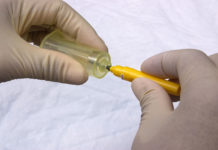
A dual vaccine against anthrax and plague has been developed
A team of researchers has engineered a virus nanoparticle dual vaccine. It will protect against Bacillus anthracis and Yersinia pestis, the organisms that cause anthrax and plague respectively.
These two are the most commonly used organisms for bioterrorism. At present, according to USFDA, there is a vaccine available for anthrax but no vaccine is available for plague.
In India, the last major outbreak of plague occurred in the district of Beed, Maharashtra (bubonic type) and Surat in Gujarat (pneumonic type) in September 1994. A total of 876 cases and 54 deaths were reported.
The National Centre for Disease Control (NCDC), Delhi has identified four specific areas where plague is affecting wild animals in India; the tri-junction of south India (Karnataka, Andhra Pradesh and Tamil Nadu), Beed belt in Maharashtra, Rohru in Himachal Pradesh and Uttarakhand. Plague is a very severe communicable disease (pneumonic type), with case fatality rates of 50-60% if left untreated.
IN INDIA, THE LAST MAJOR OUTBREAK OF PLAGUE OCCURRED IN THE DISTRICT OF BEED, MAHARASHTRA (BUBONIC TYPE) AND SURAT IN GUJARAT (PNEUMONIC TYPE) IN SEPTEMBER 1994. A TOTAL OF 876 CASES AND 54 DEATHS WERE REPORTED
Anthrax is normally present in animals in southern India but is less frequent to absent in the northern Indian States.
National Centre for disease control (NCDC), Delhi reported 6 outbreaks of anthrax in India during the year 2014.
Anthrax is highly fatal when transmitted through inhalation and it’s spores can remain viable for many years, and can be disseminated as invisible aerosol which can affect thousands of people at the same time.
The Centers for Disease Control and Prevention lists Yersinia pestis and (the agent for plague) and Bacillus anthracis (the agent of anthrax) as important organisms that might be used for bioterrorism. Following the horrific attack on the World Trade Center in New York City on September 11, 2001, there were subsequent mailings of anthrax spores through the US postal department to various media and congressional offices leading to the development of inhalational anthrax in 11 people. Ongoing revelations of terrorist plans and activities in many countries, have made bioterrorism a prominent source of concern to hospital infection-control programs.
Using the virus bacteriophage T4, scientists developed the vaccine by incorporating key antigens of both B. anthracis and Y. pestis into one formulation. Two doses of this vaccine provided complete protection against both inhalational anthrax and pneumonic plague in animal models.
Even when animals were threatened with lethal doses of both anthrax lethal toxin and Y. pestis CO92 bacteria, the vaccine was shown to be effective.
The study was published in mBio, an open-access journal of the American Society for Microbiology.
“This dual anthrax-plague vaccine is a strong candidate for stockpiling against a potential bioterror attack involving either one or both of these biothreat agents,” the researchers noted in the study.
Their results demonstrate that T4 nanoparticle is a novel platform for developing multivalent vaccines against pathogens of high public health concern.












